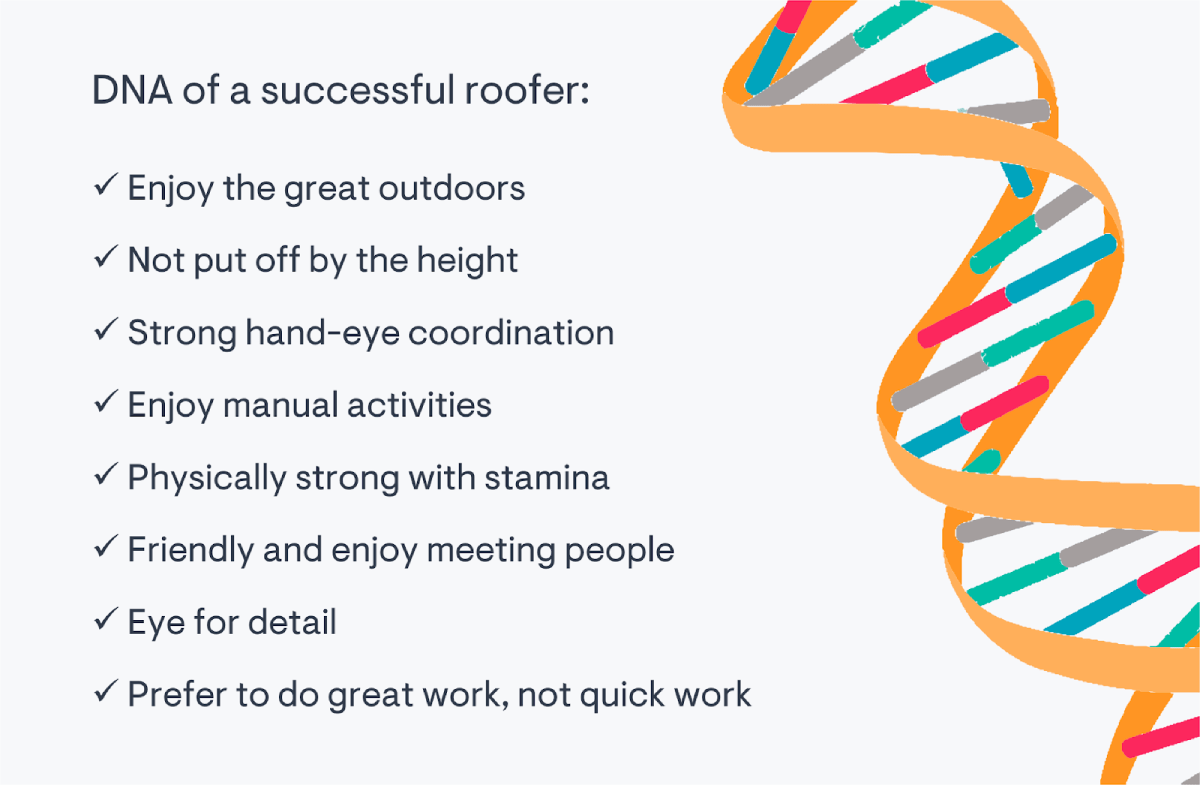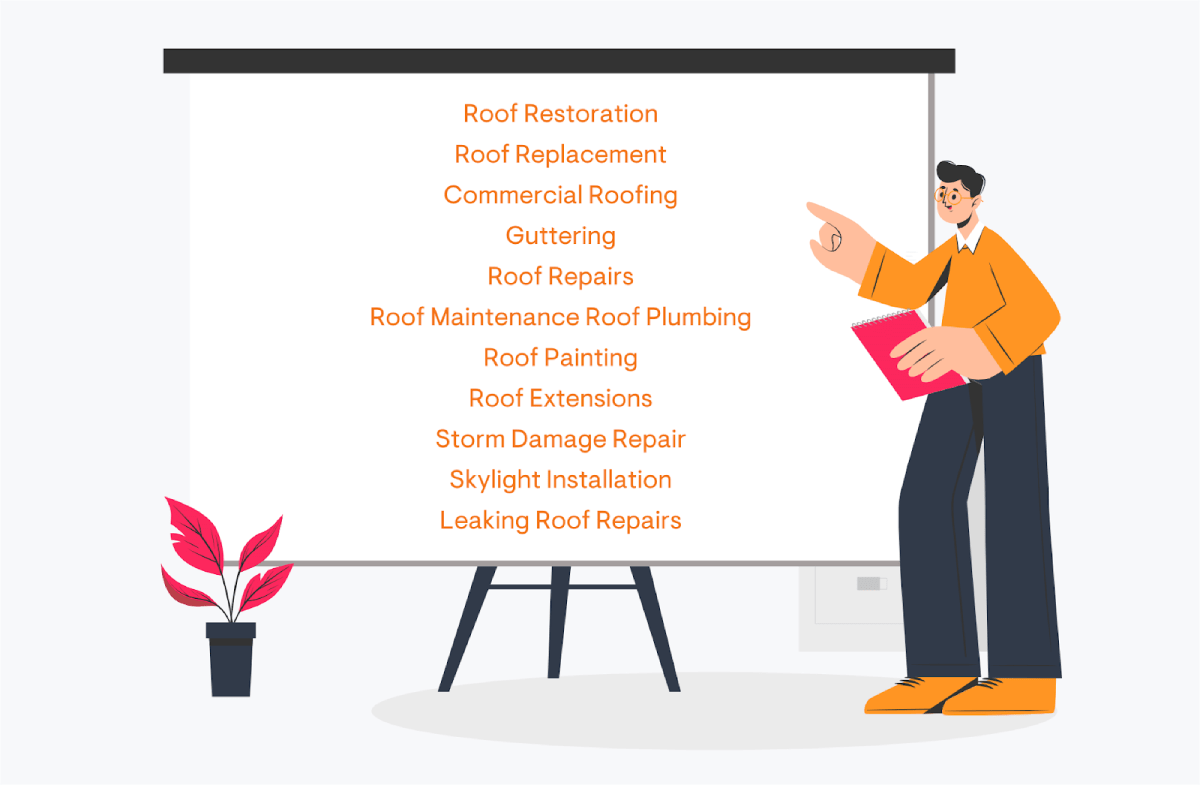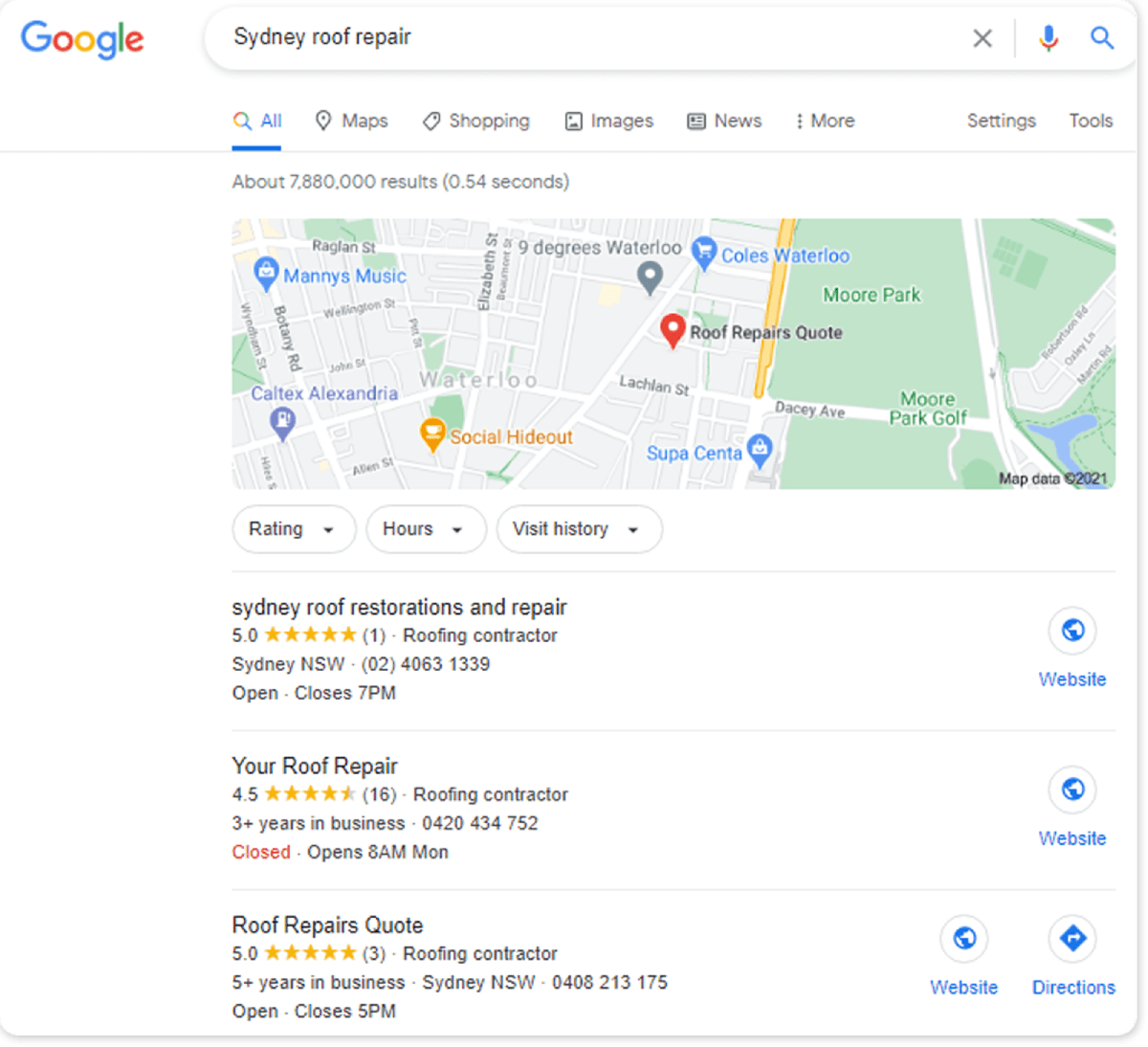How To Make a Roofing Business From Scratch [BONUS: Includes Free 7-Step Marketing Strategy]
Starting a roofing business is scary, exciting, and maybe even overwhelming. So here’s the good news – building a successful roofing business is like putting together your favorite jigsaw puzzle. It all comes down to knowing how to assemble the pieces in the right order.
Whether it’s your new roofing website, picking the right name, choosing your services, or identifying your target market, we’ve mapped out your entire journey from “I think I could run my own roofing business” to “I run a successful and profitable roofing business”.
Ready future business owner? Here’s what you need to do…
Maybe you’re looking to start your working life by learning roofing skills and starting your own company. Or maybe you’ve worked in the roofing industry for years and woken up one day thinking “hang on, I could do a better job than my boss”.
Wherever you’re coming from, the road ahead is the same.
Because starting a roofing business means facing specific obstacles and having to solve classic business problems like how to build exposure, how to earn the trust of your market, how to generate leads, and how to run a profitable company.
Forgive the pun, but you’ll want to raise the roof when you see the roadmap we’ve planned out for you.
If you’re ready to kick start your own roofing business, here’s everything you need to know.
What are your roofing goals?
Webster’s Dictionary defines roofing as…blah blah blah.
You already know what type of roofing jobs are waiting for you. We’re not here to explain the difference between structural terracotta roof tiles and synthetic Spanish barrel tiles (mostly because we don’t know the difference).
Launching a roofing business means you’ll be installing, repairing, and maintaining roofs of all different types, sizes, and materials.
Terracotta, asphalt, metal, zinc, aluminum, shingles, slate, solar.
These will all be second nature to you by now, so we won’t regurgitate Wikipedia and try to teach you how to be a roofer. But we are experts on turning new businesses into successful lead-generating machines that become highly sought after in their local area, so let’s focus on the bigger picture.
Starting with whether a roofing business is a profitable idea in the making or not…

Is a roofing business profitable?
$100 billion.
That’s where the global roofing market value stands. So it doesn’t matter if you’re looking to set up a new roofing business in the United States, Australia, the UK, or on a tiny island off the coast of South Africa, there’s a ready-made market for you.
One of the most common questions any business owner faces – including a roofer – is “what market is there for me?” and roofing is in the unique (and valuable) position of being a growing industry as urbanization and the demand for homes increases.
If you’re not feeling confident yet here’s a couple of figures to make you smile – US roofing contractors are in their fourth consecutive year of improved profitability and double-digit increases in sales.
So the question isn’t “Is a roofing business profitable?” but “how do I make MY roofing business profitable?”.
With plenty of roofing services to offer and plenty of ways to attract new customers, the way you build your new business from the ground up is crucial to your future success. Oh, and we’ve already mapped out that process step-by-step.

What qualifications do you need to be a roofer?
There are some businesses you can open without any qualifications, like selling homemade t-shirts on an eCommerce website.
The roofing does NOT fall into this category.
How you set up your roofing business, starting with your qualifications, accreditations, and licenses, will have a significant impact on your success or failure. While the requirements to become a roofer vary from country to country, you’ll typically need to complete an apprenticeship or traineeship to become a roofer.
Keep in mind there are alternate ways to upskill and impress potential employers as you become a roofer. In the United States, it’s possible to enroll in a college course, like a Level 2 Diploma in Roof Slating and Tiling, and learn some of the necessary skills to help you land an apprenticeship or traineeship down the line.
Your country may also require you to meet industry standards through completing short courses, such as a ‘Work Safely at Heights’ course provided through a Registered Training Organization (RTO).
Looking for more info on roofing qualifications?
- Discover the qualifications required in the USA
- Discover the qualifications required in Australia
- Discover the qualifications required in the UK

What are the most popular insurance types for roofers?
No business is without risk, but roofing does create the opportunity for accidents in a way less hands-on businesses don’t have to worry about.
Roofing is a high-risk occupation, especially since you work with both feet off the ground. For this reason, the biggest risk is having you or a member of your roofing team fall and get hurt. You don’t want to end up with a broken leg, but it’s not just your health and safety you’ll need to watch out for.
Running a roofing business brings risks to the property you’re working on, damage to equipment, and injuries to third parties.
One lawsuit has the potential to cripple (or even close) your roofing business, so it’s best to be prepared. Your individual needs will dictate the specific insurance policies and coverage that’s right for you, but we’ve rounded up some of the most popular insurance types that roofers around the world use to protect themselves.
General Liability Insurance
General liability insurance is designed to protect you if a third party (which is typically your customer) incurs an injury or property damage. This could occur if a tool falls off the roof and strikes your customer on the head, or if your ladder falls and smashes through a window.
Your choice of insurer will provide specific details about what is and isn’t covered by general liability insurance, but this broad coverage helps protect you if an accident or injury does happen.
Worker’s Compensation Insurance
You’re only as successful as your team, which makes protecting your roofing business employees crucial. You can create a thousand safety sheets and train your team on the latest safety standards, but accidents do happen.
If one of your staff suffers an injury at work, you may be liable without Worker’s Compensation Insurance to protect you. This could leave you to foot the bill for surgeries, medical expenses, rehabilitation costs as well as lost wages.
You’d much rather have your team helping you deliver awesome service and making roofs across your suburb look amazing, and with Worker’s Compensation Insurance you can focus on those goals without worry.
Vehicle Insurance
If you plan on using trucks, vans, or trailers to get to and from your customer’s houses and businesses, it’s worth insuring those vehicles. It’s a mistake to think personal auto-insurance will have your back if the damage was work-related, so don’t let yourself get caught out by the fine print.
With vehicle insurance, you’ll be protected if you accidentally damage someone else’s vehicle, or if you or your employees are injured while operating a work vehicle. Medical bills can be costly, but with vehicle insurance, you’ll be covered for all accident-related expenses.
Professional Liability Insurance
Professional liability insurance isn’t always the first coverage that comes to mind for new roofing business, but it can keep you out of financial trouble if you’ve given a recommendation – possibly relating to a specific roofing product or a form of treatment designed to maintain a customer’s roof – that has led to financial loss or damages.
Roofing is a very client-facing industry and you’ll spend plenty of time fielding questions about roofs, the best type of roofing materials, and so on, so it’s worth protecting yourself just in case.

Are you cut out to be a roofer?
We’ve covered the legal hurdles you’ll need to jump, but let’s take a step back for a second.
There are personal requirements to become a successful roofing business owner, and it’s just as important you tick those boxes too. You wouldn’t encourage someone to launch a lawn care business if they find grass itchy and dislike manual labour.
The business owners who succeed as roofing company owners get their strategy and marketing right from the get-go (don’t worry, we’ll cover that shortly). But more importantly, they love being outdoors.
As a roofer, you’ll spend plenty of time outside, exposed to sun, wind, and even rain, with a significant amount of manual labour-style tasks. Of course, if you grow your roofing business and take on employees or subcontractors down the line you may revert to a more managerial role, but the first few years of your roofing business will be hands-on, literally.
Here are a few personal characteristics to look for in yourself if you want to run a roofing business:
Not put off by the height
Strong hand-eye coordination
Enjoy manual activities
Friendly and enjoy meeting people
Eye for detail
Prefer to do great work, not quick work
If we’ve just described you, you’ve got the DNA of a successful roofer already.

Why roofing business profit margin matters
We get it, it’s easy to throw around numbers like “Roofing is a $100 billion industry” and expect you to go “oooh”.
But out-of-context numbers don’t tell the whole story.
What matters to your roofing business isn’t total revenue, but profit margin, so let’s break down a few facts and figures for you.
When you launch your new roofing business, there’s a good chance your margins will be razor-thin. As you invest in equipment, marketing, wages, and so on, you’ll be spending more at first to get your business up and running. This can be frustrating for new roofers, but as you scale up your profit margins widen and you end up with more in your pocket.
The average profit margins for roofers in 2021 are between 6% and 14%. Overall, this is in line with other sub-contractor industries within construction, with niche industries typically seeing smaller profit margins.
Considering the roofing industry means there are plenty of times you’ll be called back to make changes, fix leaks, and satisfy difficult clients, we think you deserve more than 14% profit – make sure you keep reading to find out the strategies we recommend you use to drive revenue and profits up.
BONUS TRADIE DIGITAL TIP: Eventually, you’ll max out your productivity. If you want to generate more revenue you’ll have to offer additional services and hire new roofers to provide those services. This type of scaling is crucial to long-term success.

What type of roofing services will you offer?
‘Roofer’ is a general term that most people will type into Google whether they’ve got a small leak in the roof or need a completely new set of tiles laid down.
In setting up your new roofing business you’ll need to know what services to offer to best meet the needs of your customers. This is a fine line because you don’t want to limit your service options and leave money on the table, but you also don’t want to offer every single roofing service under the sun – particularly if some are more time-consuming or less-profitable than others.
We’ve rounded up a list of the most common roofing services so you’ll be able to pick and choose what best suits your skills and goals.

| Roof Restoration | Roof Replacement | Commercial Roofing |
| Guttering | Roof Repairs | Roof Maintenance |
| Roof Plumbing | Roof Painting | Roof Extensions |
| Storm Damage Repair | Skylight Installation | Leaking Roof Repairs |
“Can’t I just tell people I’m a roofer without listing what I do?”
If you wanted to be a home handyman-style roofer, this strategy would work.
Every time someone had a leak in their garage or was missing a few shingles from the roof you could let them know if you had the skills to help out, but this doesn’t work if you want to generate consistent revenue and scale your new roofing company.
Most people will look for roofing help on Google – with 93% of online experiences starting with Google, the best way to reach these customers is to match the keywords they type in, with the content on your roofing website.
It’s not rocket science. The more individual service pages you have, the more keywords that can be matched to a potential customer’s search.
So if someone types in “Metal Roof Replacement Help” and you have a metal roof replacement page full of tips on how to save money, extend metal roof lifespans and spot the early warning signs of trouble, then you have a good shot at ranking on Google and bringing that lead to your website.

How to start a roofing business in 7 simple steps
Starting a business is a complex and complicated process (as well as exciting) so while we haven’t crossed EVERY single bridge – for example where to buy uniforms or how to store spare tiles in your garage – these are the core steps you need to take to give your new roofing organisation the best possible foundation for success.
You’ll need more than a nail gun and a pair of work boots to succeed, so here are the most important steps you need to take.
#1 – Find an accountant
You’ll be up on customer’s roofs working your magic, but your business will live and die by the numbers. Instead of taking night classes to learn the basics of small business accounting, find an accountant to handle your books, tax requirements, and budgets.
This will allow you to create a financial plan from day one to make sure every piece of equipment you hire or roofer you bring onboard works within the bigger picture. When tax time rolls around, you’ll be thankful everything is taken care of.
#2 – Choose a name for your roofing business
Among all the marketing strategy and legal requirements, picking your roofing business name probably isn’t at the top of your to-do list…but it should be.
Your roofing name is going to play a HUUUUUGE role in helping you stand out from the competition and leave a positive and memorable impression in the minds of your customers. With thousands of competing roofing companies, a name like ‘John’s Roofing’ could vanish in the minds of your leads.
But let’s not get ahead of ourselves, here are a few simple tips to help you nail your roofing business name:
| Don’t ask for everyone’s help | Keep things simple |
|---|---|
| Every man and his dog will have an opinion on your name. Limit your brainstrust to yourself, your close friends and family, marketing experts, and legal experts. | You don’t want a name that’s impossible to spell. With 74% of people using voice search to find local businesses, including roofers, a name that’s hard to say won’t be searched. |
| Scope out the competition | Think about SEO |
| Check out the other roofers in your area to a). make sure your name isn’t taken or similar to someone else’s and b). Find a name that stands out from the crowd. The worst outcome would be launching a business that gets confused with a competitor. | Your customers are going to look for you on Google, with 46% of ALL searches for local businesses. Make sure your name is easy to remember and spell. Bonus points if your name includes your location, like “Sydney Roofing Rockstars” as this will help your SEO. |
This will allow you to create a financial plan from day one to make sure every piece of equipment you hire or roofer you bring onboard works within the bigger picture. When tax time rolls around, you’ll be thankful everything is taken care of.
#3 – Define your service area
Your roofing business can’t help everyone.
Identifying your target area and sticking to it is good for business because a). it stops you from traveling so far for jobs that you end up losing money on transport costs and travel time, and b). it helps you stand out in your local area.
It’s better to be the #1 roofer in your area than a small fish in a big pond by trying to target an entire city.
Of course, this goes both ways. You don’t want to set your boundaries too small, but a controlled radius is a simple way to control your overheads as you build a reputation for being THE roofer to turn to.
BONUS TRADIE DIGITAL TIP: Add a dynamic Google Map to your website so people can see exactly where you are and how far from their home or business you’re based. This will help drive local leads who see you close by and think “oh great, a quick and easy fix”.
#4 – Identify your target market
Your business is NOT for everyone.
And if you try and include all customers, you’ll end up excluding them.
Here’s what we mean…let’s say you want to please everyone so your website says “#1 Roofer in the City. Call now for free quotes and great deals”. Only…no one calls. Why? Because in targeting everyone, you appealed to no one.
A business owner seeing your website thinks “Hmmm I need a specialized commercial roofer, I’ll keep looking”. And a homeowner with a tired and old roof thinks “Hmmm I need a specialized tile replacing roofer, I’ll keep looking”.
It’s only when you identify your audience and start speaking directly to their problems that your new roofing business will grow.
Do you want to service residential roofs? Commercial roofs? Construction project roofs? Strata-related roofs?
And once you’ve found your niche, you’ll need to define your services. Will you clean roofs or only replace them? Will you repaint roofs or only restore them?
Answering these questions needs to happen before your website goes live to make sure your business strategy is in line with your marketing strategy.
#5 – Create a Google My Business Listing
GMB.
These are three of the most powerful letters in a roofer’s arsenal, standing for Google My Business.
If you’ve ever searched for a local restaurant, or painter, or retail store, there’s a good chance you’ve seen a GMB pop up in the search results. This occurs in the form of one primary GMB listing in the right side of your Google results, a selection of local businesses on the Google Map, and three relevant local listings below the map – this is known as the ‘local pack’.
With 46% of ALL searches having local intent, popping up as a GMB result is how you build a client base in your local area.
People are specifically looking for local roofers, and if they see someone on the map close by or a GMB listing that’s glowing with plenty of 5-star reviews, then that business has a massive advantage.
For example, if someone was searching for ‘Sydney roof repair’ they’d see the following result…
That searcher can click on websites, read reviews and find directions all on the same screen. They don’t have to go through each organic result on Google, which is time-consuming, but have all the info they need on one screen.
And the only way to appear in a local search like this?
With your own GMB.
Even better, setting up a GMB is 100% free. All you need is a Gmail account and a few minutes of your time.
#6 – Build a website
Don’t have a website?
Then don’t expect to have many bookings in the calendar. Your customers expect you to have a website and your competition all have websites, which means YOU need a site too.
This can be off-putting for plenty of roofers because the thought of a site stirs up mental images of handing over $5,000 or $10,000 to a marketing agency and being left in the dark while they create a site for you.
It’s worth pointing out this method is used by so many roofers because the price of a website isn’t a cost – but an investment.
A good website is SEO-friendly so you can rank on Google and generate site traffic. A good site is designed to turn that traffic into leads. And a good site is full of helpful content to convince those leads they should become paying customers.
Discover our step-by-step process of building an SEO-friendly and customer-friendly website.
So while it’s true you pay extra for a pro website, you have more tools to help you generate revenue, recoup your costs, and turn a profit.
But starting a roofing business means tight budgets and careful spending, so there are other options that can save you thousands of dollars. Website builders are easy-to-use platforms that let you pick ready-made templates, drag-and-drop design elements, and launch a website in under an hour.
Wondering if it’s worth building a DIY website? Discover the ultimate Pros and Cons!
We recommend Pedestal, the website builder created specifically for roofers and other trade businesses. You don’t need any design experience (that’s all built into the platform), and marketing experience (your marketing strategy is built into the platform too), and since Pedestal websites generate 26.7% more leads than other website builders you’ll have plenty of work coming through the door from the start.
Curious about a Pedestal website? Check out the platform for FREE here.
#7 – Add your roofing business to relevant directories
You’ve probably heard of SEO, but how much time have you spent learning about local SEO?
SEO is great if you sell products online and you want your website to pop up when someone is searching in every capital city in the country. But if you’re a roofer you’re not going to be driving more than 50 or 100 miles away to land a job.
To make sure your website starts ranking in your local area, you need to add your business listing to relevant directories. Doing this has TWO major benefits:
- Traffic: The more directories you’re in, the more chances for people to find your business, click on your website, and end up as site traffic. And since roofing is a number’s game, more traffic means more chances to secure a lead.
- Better Rankings: Google uses a range of ranking factors to determine whether you’re credible and trustworthy enough to appear when people look for local roofers. The more relevant directories you’re in (that means adding your business to home improvement listings, not massage or restaurant listings), the more Google trusts you – and that leads to better rankings.
You might already have seen the effect of this two-for-one benefit in action. Maybe you started on Yelp, Trustpilot, or the Yellow Pages to look for help around the house.
And if you couldn’t find anyone relevant you went searching on Google, for example, “emergency roof repair near me”.
Putting YOUR roofing business on those relevant directories gives you two bites at the cherry. Either a customer finds your directory listing, or they find your business ranked for their Google search.
DON’T MAKE THIS ONE MISTAKE!!!
Sorry to go caps lock on you, but adding your roofing business to relevant directories is super powerful…but it can backfire spectacularly.
Remember when we said Google wants to know which roofers to trust and reward with rankings? Well if you make a spelling mistake or change the wording every time you list your business on a new directory, Google won’t trust you. After all, why would a trustworthy business keep changing their most important info?
If this sounds scary there is an easy fix. Always focus on your NAP:
N = Name of business
A = Address of business
P = Phone number of business
Your NAP has to be EXACT everywhere it’s listed. That means you can’t say “street” in one version of your address and abbreviate it to “st” in another. To make things easy, your GMB is your original NAP version. As part of setting up your GMB profile you’ll need to enter your NAP, so consider that the gold standard.
If you match your business listing EXACTLY to your GMB, you’ll stay out of trouble and get a sweet rankings boost.

Do roofing businesses fail?
It’s not nice to think about your business going under, but being realistic about your chances of success (instead of sticking your head in the sand) can actually help you spot signs of trouble and move past them.
As someone who wants to start their own roofing business you likely fall into one of two categories:
- You’re new to the industry and ready to strike out on your own
- You’ve been in the industry for ages and you’re tired of contributing to someone else’s retirement fund
Both of these come with the same problem – you’re not a salesperson.
It’s all too easy to find the path of least resistance when facing something you’re not great at. As a roofer who doesn’t have a ton of sales experience, you can quickly find yourself falling back on “oh my word of mouth is enough, I don’t need to sell my services to people”.
In the short term, this might work, but over the long run, you need alternate lead-generating strategies outside of your word of mouth buzz. This either leads to a roofing business that dies a slow death through leads that dry up or roofing businesses that hemorrhage money because their strategy to attract new clients is all over the shop.
To avoid the common pitfalls that swallow up to 50% of ALL roofing businesses, keep these simple lessons in mind at all times:
- Always have a strategy: Whether it’s for your website, your marketing, your target market, or the service you offer. Business plans and marketing plans are worth your time.
- Crunch the numbers: You didn’t become a roofer to handle numbers all day, but that’s exactly what you’ll need to do. Know how much it costs to acquire a customer, what your profit margin is, what your return on investment for each marketing strategy is. Numbers are your best friend.
- Go at your own speed: Bigger isn’t always better. The thought of more money sounds great, but if you stretch yourself too thin or overinvest in equipment, you can send your business broke. It’s better to grow sustainably fast, not significantly fast.

How to find customers for your new roofing business
Nothing is stopping you from going old-school with your lead gen tactics, whether it’s letterbox drops, flyers under car windscreen wipers, a billboard on the main road, or good ol’ fashioned word of mouth.
But these tactics are old-school for a reason.
In 2021, bringing leads to your roofing business is best done through digital channels, and we’ve rounded up the most effective of those for you.
| SEO | Google Ads |
|---|---|
|
SEO leads – which are earned through a high-ranking and visible website on Google – close at 14.6%. Compared to the 1.7% conversion rate of print, flyers, and other outbound marketing strategies. SEO can take 6 to 12 months to see results (though Local SEO can see results in weeks) but the exposure at the top of Google creates constant leads and predictable revenue for your roofing business. For the best results, combine SEO and Local SEO to be available everywhere on Google. |
Looking for faster leads?
Google Ads is a Pay-Per-Click marketing strategy or PPC. You bid on certain keywords which trigger your ads. And you only pay when those ads are clicked so you’re in control of your budget. Paying for leads in this way is also predictable as you know exactly how much it costs to acquire a new customer, so you can scale up or down easily. |
| Facebook Ads | Online Directories |
| Similar to Google Ads, Facebook Ads target Facebook users. But instead of keywords, you create custom audiences based on filtered features you want to include.
For example, men aged 25 – 44, living in your state, and interested in real estate. You create the targeted list, Facebook shows your ad to those people. It’s that simple. |
Yelp, Yellow Pages, FourSquare, HotFrog.
These types of small business directories are perfect for roofers. Not only will you boost your visibility but you’ll drive traffic to your roofing website AND improve your Local SEO. That’s a win-win-win. |
Curious about the price of a Google Ads campaign? Explore the ‘Ultimate Google Ads Price Guide’.
You’re not just a roofer, you’re a salesman too
By now you have all the steps needed to set up and run a successful roofing business, but this takeaway is the most important…
You’re a roofer, but you’re also a salesman.
Your business CANNOT survive on the strength of your products and services alone. That attitude sends more roofing companies bankrupt than any other.
It’s not easy to see yourself as a salesman, and thankfully you don’t have to look at it that way. You’re not selling ice to Eskimos, you’re selling a service people with roofs desperately need. Whether it’s patching a frustrating leak, fixing storm damage, or retiling a roof before a sale, you’re selling your business – but more importantly, you’re solving problems.
Every time you communicate with a lead, or just a curious prospect, you can sell yourself to them by helping to solve their problem in every way possible.
- If they have price questions, give them multiple pricing or finance options.
- If they have concerns about value, offer free quotes and estimates.
- If they worry about results, offer warranties and guarantees.
Yes, it’s your job to get up on the roof and work your magic, but you can only do that AFTER you’ve convinced someone to hire you – and that happens by putting your customer’s needs first, figuring out their problems, and offering easy solutions.

Let’s recap what we’ve learned in 30 seconds
Starting a roofing business means you’ll be working in the service industry.
It’s easy to think your skills as a roofer will make or break you, but that’s not true. Of course, you want to be a qualified roofer with all the necessary insurance and skills, but as a service-based business, you can generate leads and bring on new customers that will keep you running year after year.
External factors like the weather, the price of suppliers, and your target market’s financial situation will impact your revenue.
But you have the power to tip the scales in your favor with:
- A professional website (either made by you on a platform like Pedestal or built by a freelancer or agency)
- A Google My Business (GMB) listing
- Listings on relevant directories
- A selection of marketing strategies to drive leads (SEO, Google Ads, Facebook Ads)
You may not feel like a salesperson, but your roofing business needs sales to survive.
If you take just one thing from this ‘How To Start a Roofing Business’ guide, let it be this – you don’t have to be pushy or aggressive to sell your services.
When you build your roofing business around the idea that every customer has a problem and it’s your job to find the solution for them, you’ll have the foundation for success.
The idea of creating a roofing website can be overwhelming, especially if you’ve got no experience. But with simple website builders created specifically for tradies – like Pedestal, you don’t need any experience at all.
Pedestal is the built-for-tradies website builder that comes pre-optimised with marketing strategies embedded in the design. With a focus on ROI, Pedestal websites generate 26.7% more leads than other website builders.
Click here to start your FREE trial today and create your own Pedestal website within the hour.









